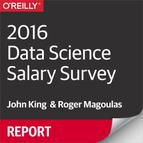Book Description
In this fourth edition of O’Reilly’s Data Science Salary Survey, 983 respondents working across a variety of industries answered questions about the tools they use, the tasks they engage in, and the salaries they make. This year’s survey includes data scientists, engineers, and others in the data space from 45 countries and 45 US states.
The 2016 survey included new questions, most notably about specific data-related tasks that may affect salary. Plug in your own data points to the survey model and see how you compare to other data science professionals in your industry.
With this report, you’ll learn:
- Where data scientists make the highest salaries—by country and by US state
- Tools that respondents most commonly use on the job, and tools that contribute most to salary
- Two activities that contribute to higher earnings among respondents
- How gender and bargaining skills affect salaries when all other factors are equal
- Salary differences between those using open source tools vs those using proprietary tools
- Salary differences between those who rely on Python vs those who use several tools
Participate in the 2017 Survey
The survey is now open for the 2017 report. Spend just 5 to 10 minutes and take the anonymous salary survey here: https://www.oreilly.com/ideas/take-the-2017-data-science-salary-survey.
